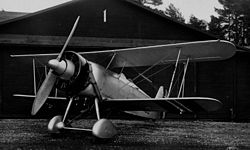Koneen ensilento tapahtui vuoden 1929 ja se tuli sarjatuotantoon J6-tunnuksella. Se oli Ruotsin ilmavoimien käytössä vuoteen 1941 asti.

Koneen kehittänyt Svenska Aero meni konkurssiin vuodenvaihteessa 1932-33. Valmistajaksi tuli ASJA (joka oli pääosin junia valmistava yhtiö). Sen lentokoneosastosta tuli SAAB 1930-luvun lopussa.
Ruotsi lahjoitti joulukuun 1939 alussa kahdeksan Jaktfalken II -konetta Suomen ilmavoimille. Koneet olivat Ruotsin ilmavoimien vanhimmat Jaktfalkenit, jollaisia sota-avussa on tapana antaa. Niitä käytettiin Kauhavan Lentosotakoulussa koulutukseen.
Lentosotakoulun käytössä oli kolme konetta vuosina 1940–1945.
---------------------------------------------------------------------------------------------------
 Kuva: Wings Palette
Kuva: Wings PaletteJaktfalken II
Tyyppi: Kaksitaso
Miehistö: 1
Moottori: Bristol Jupiter VIIF, 460 hv
Kärkiväli: 8,8 m
Pituus:7,5 m
Korkeus: 3,46 m
Lentopaino: 1375 kg
Suurin nopeus: 300 km/h
Lakikorkeus: 7800 m
----------------------------------------------------------------------------------------------------------------
Sweden gave three Jaktfalkens (two J 6Bs and one J 6A) to the Finnish Air Force on 8 December 1939. These were the oldest ones of the type that Sweden had; it was common to give away the oldest equipment as military aid. The aircraft were used for training at the airfield at Kauhava until 1945, when all were scrapped
Svenska Aero Jaktfalken ("Gyrfalcon") was a Swedish biplane fighter aircraft, constructed in the late 1920s. The aircraft was first manufactured by Svenska Aero and later by AB Svenska Järnvägsverkstädernas Aeroplanavdelning (ASJA).
The Jaktfalk was constructed and manufactured by Svenska Aero as a private venture. The company contacted the Swedish Aerial board, requesting guidelines and wishes for a fighter aircraft. When no reply was received, Svenska Aero began to look at foreign designs to get some guidance. Jaktfalken was a conventional biplane equipped with an Armstrong Siddeley Jaguar 9-cylinder radial engine. The landing gear was fixed and there was a sour under the tail section. The fuselage skeleton was made of welded beams covered with fabric. The fore and aft part of the fuselage was covered in aluminum sheet. There was a fuel tank between the engine and the cabin, which contained enough fuel for 2,5 hours of flying.
The Swedish Air Force test pilot Nils Söderberg was given the mission to try out the new prototype at the Barkarby air force base. After one of his landings he said "this is the best aircraft that I have flown so far".

On November 11, 1929 the Jaktfalk was presented for representatives from authorities and the press. The Swedish Air administration decided that three Jaktfalken and three British Bristol Bulldog II fighters were to be ordered for comparative tests.
The prototype was bought by the Swedish Air Force on January 9, 1930 and given the designation J 5. By February 1930, the Air administration decided to use a Bristol Jupiter engine as the air force standard engine. The designer, Carl Clemens Bücker was forced to modify the two ordered aircraft, by making new engine attachments and make modifications to the fuselage. These aircraft were given the name Svenska Aero Jaktfalken I (or J 6 in the Swedish Air Force).
The order was followed by a new one for 5 aircraft with Jupiter VII engines in 1930. During test flights, powerful vibrations were encountered. Both Svenska Aero and CFV tried to solve the problem, without success. The aircraft was still approved by the Swedish Air Force. Bücker and CFV tried to modify the landing gear and the fuselage after the delivery. The aircraft had now a more angular fuselage and the Jupiter VIIF was chosen as the engine. The Swedish Air Force received three Jaktfalk IIs in 1932.
Svenska Aero tried hard to earn export orders for the Jaktfalk. Military representatives from Argentina and Japan came and tested the aircraft, but no orders followed. The only export order came from Norway, who ordered one aircraft in 1931, equipped with an Armstrong Siddeley Panther IIIA engine. This aircraft was used as a comparative aircraft against a Hawker Fury. When the Swedish Air Force wanted an additional seven aircraft in 1933, Svenska Aero had been bought by ASJA and the deliveries come from the new manufacturer, who made some minor modifications to the stabilizer and the windshield.
Ei kommentteja:
Lähetä kommentti
Kaikenlaiset kommentit ovat tervetulleita.